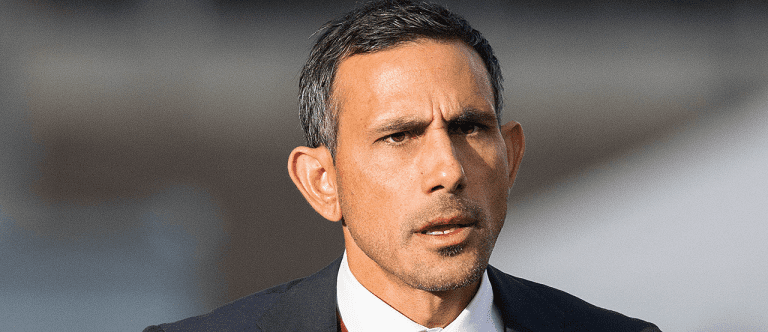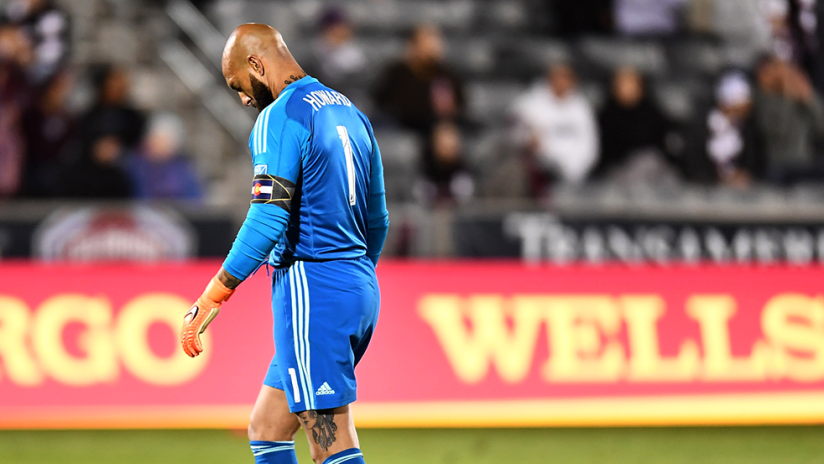English teachers profess that it’s more powerful to show than to tell. So here’s the rundown of an MLS team over the last eight years:
YEAR |
CONFERENCE RANK |
PPG |
PLAYOFFS? |
|---|---|---|---|
2011 |
5th |
1.44 |
Y |
2012 |
7th |
1.09 |
N |
2013 |
5th |
1.50 |
Y |
2014 |
8th |
0.94 |
N |
2015 |
10th |
1.09 |
N |
2016 |
2nd |
1.71 |
Y |
2017 |
10th |
0.97 |
N |
2018 |
12th |
0.80 |
? |
They’ve finished last or next to last in the conference in three of the last four years. This year, they are last. They’ve lost five in a row. Most recently, the Colorado Rapids dropped a 4-0 result to NYCFC.
Per American Soccer Analysis, they have the 10th-highest salary total, and the 9th-highest average salary. Their six highest-paid players are:
Player |
Base Salary |
Total Compensation |
|---|---|---|
<a href="/players/tim-howard">Tim Howard</a> |
$2,000,000 |
$2,475,000 |
<a href="/players/shkelzen-gashi">Shkelzen Gashi</a> |
$1,575,000 |
$1,668,750 |
<a href="/players/stefan-aigner">Stefan Aigner</a> |
$800,000 |
$845,000 |
<a href="/players/yannick-boli">Yannick Boli</a> |
$774,999 |
$907,499 |
<a href="/players/joe-mason">Joe Mason</a> |
$650,000 |
$682,500 |
<a href="/players/tommy-smith">Tommy Smith</a> |
$600,000 |
$639,999 |
<a href="/players/danny-wilson">Danny Wilson</a> |
$500,000 |
$540,000 |
*All figures from MLS Players Association Salary Guide
That’s nearly $7 million on six players.
Gashi, Aigner, and Boli have a combined two starts this year, totaling fewer than 300 minutes played. Mason leads the line for an attack with the second-fewest goals scored. Howard, Smith and Wilson head a defense that ranks 11th in the league.
While acknowledging the MLS Players Association's numbers aren’t a perfect measurement and more goes into signing players (transfer fees, etc.), Colorado's weekend opponent, NYCFC, pay roughly $5 million for:
Player |
Base Salary |
Total Compensation |
|---|---|---|
<a href="/players/maximiliano-moralez">Maxi Moralez</a> |
$2,000,000 |
$2,000,000 |
<a href="/players/jo-inge-berget">Jo Inge Berget</a> |
$600,000 |
$816,666 |
<a href="/players/alexander-callens">Alexander Callens</a> |
$500,000 |
$564,000 |
<a href="/players/maxime-chanot">Maxime Chanot</a> |
$375,000 |
$408,000 |
<a href="/players/jesus-medina">Jesus Medina</a> |
$650,000 |
$770,833 |
<a href="/players/anton-tinnerholm">Anton Tinnerholm</a> |
$350,000 |
$434,000 |
<a href="/players/alexander-ring">Alexander Ring</a> |
$370,000 |
$411,000 |
The Rapids have four Homegrown Players on their roster. Those players have a total of zero MLS starts this year (although Kortne Ford probably would have, had he been available for selection); two have been loaned out.
The Rapids haven’t had a great run since winning MLS Cup in 2010, and the present isn't looking particularly bright.
Last week, Ridge Mahoney interviewed Sporting Kansas City head coach and de facto President of all-things-soccer Peter Vermes for Soccer America. Vermes has won four trophies; SKC have made the playoffs seven years in a row. Discussing the state of the US national team, Vermes reflected: “What is their plan? … I want to see what the plan is going forward.” It’s perhaps the most important question when you evaluate any organization. Because without a plan – as Vermes explains in the interview – any success is simply luck.
Bringing it back to Colorado: What is the plan? Since winning Cup, the club has made a clear slide downward, with just three playoff appearances in the last seven years – bottom two in four of five seasons – and on-field aesthetics that have often been worse than the results.
It’s one thing to lose. It’s another to have a bad season. It’s yet another to have a bad couple years. And then there’s struggling for the better part of a decade. We're past the realm of bad luck.
What was the plan?
In 2011, a year removed from that championship victory, the Rapids parted ways with head coach Gary Smith despite making the playoffs. They brought in Oscar Pareja, who turned over the roster, trading cornerstones Pablo Mastroeni and Jeff Larentowicz. Fair enough for a coach to want to bring in his own players, and the Rapids returned to the playoffs in Pareja’s second season. Yet Pareja then returned to FC Dallas, where he had spent more than a decade, to become the club’s head coach.

Pablo Mastroeni amassed a 46-58-41 record as Rapids head coach | USA Today Sports Images
What was the plan?
Padraig Smith was brought in as the club's sporting director in January 2015 after spending three years in UEFA's Financial Analysis Group. He was promoted to EVP and general manager in January.
After Pareja, the Rapids turned to club legend Pablo Mastroeni. It took a couple years, but the Rapids re-entered the playoff picture in 2016, even fighting for the Supporters’ Shield. It came down the final day before they ultimately lost out to Pareja’s FCD squad.
Mastroeni’s team used a stout defense and gritty performances to surprise the league. Every time you watched that Rapids team, you knew what the game looked like. It wasn’t pretty but it got the job done. It looked like they had a plan!
… until, less than a month into the 2017 season, when Colorado traded their starting defensive midfielder, Sam Cronin, and starting left back, Marc Burch to Minnesota. Neither of the two players they received in return started 2018 on the Rapids roster. The Rapids went from conceding a league-low 32 goals in 2016 to conceding 51 goals in 2017. At the end of 2017 – again just a year removed from a Conference Championship appearance – the Rapids made a managerial change.
What was the plan?
The Rapids hired their fourth manager since 2011, bringing on Anthony Hudson from the New Zealand national team.
Hudson and the front office staff opted to go against MLS trends. Whereas most clubs had turned to South America to find players, Colorado went shopping in England. He signed Smith, Mason and midfielder Jack Price from the Championship, England’s second tier, and Wilson from the Scottish league. While most teams moved toward a more fluid possession-based approach, Hudson decided to play direct, opting for a defensive-minded 5-3-2. Again, fair enough. Ignoring conventional wisdom is a strategy, and new ideas always seem silly until someone proves they work.
Except, of course, they haven't for Colorado so far.
There are caveats to Hudson’s belabored start. The current coaching staff isn’t responsible for a couple of the highest-profile acquisitions. Howard, Aigner and Gashi were all signed prior to their arrival. It also generally takes time for a new system to take hold and new players to acclimate. I like the way the Rapids play at times – it’s gritty and straight forward and unique. I’m willing to give Hudson time to establish himself.
But again, what’s the plan? Is it grizzled 20-something lower-tier British players? Is it defensive-first, counterattacking soccer?
Only Jack Price has provided a positive return from the former group and that defensive-first, counterattacking soccer is neither stopping goals or resulting in them.
Pick something. Execute it, or find a different approach. So fans can feel like the next five years might be better than the last eight.













